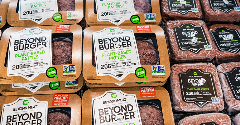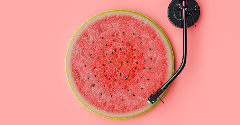News
Asian dairy: "the race is on"
15 Oct 2018The race is on to win market share in Asia’s cheese market, with the region offering “a compelling growth opportunity" for Australian dairy exporters in the medium term, according to a just-released report by Rabobank Australia.

The race is on to win market share in Asia’s cheese market, with the region offering “a compelling growth opportunity" for Australian dairy exporters in the medium term, according to a just-released report by Rabobank Australia.
Despite the robust growth outlook, the report - Asia’s fast-moving cheese markets – Australia’s race to win - warns other exporting nations with a much larger production base and export potential are also looking to expand their presence in the Asian region.There is evidence market competition is already increasing, but, according to Rabobank senior dairy analyst Michael Harvey, it is set to intensify as leading cheese manufacturers in New Zealand, the US and Europe invest in production capacity.“Over the next three years, we will see this new processing capacity come online,” he said, “which potentially be more than sufficient to service the Asian markets.”With “a lot riding on Australia’s ability to succeed in the Asian cheese market”, Harvey said, the industry “must play to its strengths” by focusing on maintaining and growing market share in the high-end segments of the market. Citing investment in dairy innovations and formulations as the way forward, he says tailored products could include improved functionality and desirability (to suit local cooking styles), clean label initiatives, nutritional demands (such as, additive free, sodium reduced) and the development of snacks tailored to local consumers.“But much of Australia’s ability to grow exports into the Asian region will hinge on the sustainable growth of our milk supply,” he said. “And, while possible, growth prospects are up against hard constraints and seasonal impediments at the moment.”Australia’s cheese production has grown in recent years, Harvey said, with close to half a billion dollars injected into the nation’s cheese-processing capacity since 2015 – to account for 54% of total capital expenditure in dairy processing.“And this bias towards cheese production doesn’t look like abating any time soon, with new processing capacity continuing to come on board, while the tight supply of milk is being prioritised for the higher growth and healthier margins offered by cheese and whey streams,” he said.“This comes at a time when Asia’s cheese imports are also growing, with China notching up an annual cheese import growth rate of more than 20% between 2012 and 2017. While growth has been around 10% per annum over the same period, in the ASEAN-5 countries of Indonesia, Malaysia, Thailand, the Philippines and Vietnam.”Harvey said growth has been slower in Japan and Korea (at an annual rate of 2%). However, these two countries, together, import ‘three times more cheese than China (importing 340,000 tonnes in 2017, compared with China’s 100,000 tonnes).“That said, China is where the growth opportunities lie for Australian cheese exports, “ he said, “with China’s annual cheese imports set to potentially double by 2023.”While cheese is not part of the traditional Asian diet, Harvey said, there are many fundamentals (namely, the increasing dominance of the younger consumer with a preference for convenience and eating out) which are supporting the forecasted increase in cheese demand over the medium term.“Most of the growth is set to come from quick-service restaurants (QSR), with many pizza and burger chains expanding their store footprints and penetration in Asia,” he said. “For example, McDonalds opened more than 900 new stores in China between 2012 and 2017 and is expecting to double the number of its stores in the next five years.”While the outlook for growth is strong, Harvey warned, there are downside risks that could disrupt growth in Asian cheese consumption. “The trade war between China and the US continues to pose the largest risk, while retail foodservice chains are showing signs of margin pressure from macroeconomic and inflationary headwinds,” he said.The report says that, while Australia is well-placed to be an integral part of global QSR supply chains, “the competitive environment is rapidly changing as other exporters also look to expand their presence in the region”.“New Zealand has set the pace in terms of growing cheese exports to Asia,” Harvey said, “and now supplies half of China’s cheese import requirements.”While in the Northern Hemisphere, he said, “a number of countries have expanded cheese production to absorb the oversupply of milk and to generate better returns from cheese versus milk powder”.“The EU and US cheese industries have sizeable and growing milk pools, as well as significant cheese production capacity, with some big investments in large-scale cheese plants coming on board,” Harvey said. “Over the next three years we will see much of this new processing capacity come online, and these facilities will have the capacity to service the Asian market, should market dynamics warrant it. This looms as a major competitive threat to Australia.”Despite Australia’s proximity to the Asian market and its ability to compete on price, Harvey said Australia has “no absolute competitive advantage” in supplying Asia’s cheese market.“As such, if Australia is to succeed in its industry-wide Asian strategy for cheese and whey-derived nutritionals it must to play to its strengths,” he says, “as an alternative supplier to other regions as well as a reliable supplier to customers demanding high-quality product.”While China will offer significant scope for growth, Harvey said, it is important not to underinvest in slower growth markets such as Japan and South Korea, particularly as trade access to these countries is improving.“Strong demand is also pegged to come from the ASEAN-5 region,” he said, “and further afield there will be opportunities to ride the QSR expansion wave into other priority markets such as the Middle East and potentially, India.“But the immediate priority for Australia to increase its cheese exports lies with the industry here sustainably increasing milk production and improving plant utilisation. While possible and Rabobank forecasts a modest growth in milk supply over the next five years, there are many headwinds to achieving this, particularly in light of the current season.”Related news

Retail landscape lacks nutritious and affordable food, says ATNi
30 Dec 2025
A rapid increase in modern food retail has given retailers growing influence over consumer diets, according to global non-profit ATNi’s latest assessment.
Read more
Debate over ban on ‘meaty’ names for plant-based products reaches stalemate
26 Dec 2025
The debate over a ban on plant-based products using “meaty” terms has reached a stalemate, leaving manufacturers in limbo and still facing overhauls to their marketing and packaging.
Read more
Multi-sensory food and drink products to gain traction in 2026
16 Dec 2025
Trend forecasters predict that sensory elements will play a larger role, helping food and beverage brands differentiate themselves in a competitive market in 2026.
Read more
Big appetite for M&A between European and US food and drink companies
3 Dec 2025
Persistent tariffs on EU food and beverage exports have helped drive record levels of M&A activity between European and US companies this year, according to analysis by ING.
Read more
Non-UPF Program extends certification scheme to entire food industry
30 Nov 2025
The Non-UPF Program has extended its certification scheme to the wider food sector, championing a move towards healthier consumption habits.
Read more
Lancet study links UPFs to chronic disease risk
26 Nov 2025
UPFs are consistently associated with an increased risk of diet-related chronic diseases, according to a comprehensive review of global evidence in The Lancet .
Read more
Concerns swirl around cinnamon’s compliance with EU law
25 Nov 2025
Cinnamon may be a top functional ingredient, but it needs stronger protocols to ensure it meets EU food safety laws and quality standards, say researchers.
Read more
Oat Barista: Innovation for game-changing beverages
20 Nov 2025
Oat Barista is a clean label, sustainable, and innovative drink base specifically designed to create the perfect foam in one single ingredient.
Read more
How younger consumers are redefining ingredient choices and rejecting brand loyalty
18 Nov 2025
Gen Z and millennial consumers’ preferences for transparency, functionality, and purpose are “redefining the very nature of consumption itself”, says SPINS.
Read more
Hybrid formats and flexible positioning to disrupt category norms in 2026
17 Nov 2025
Trend forecasters expect food and drink to move more fluidly across occasions, functions, and formats as consumers seek versatility, novelty, and convenience.
Read more